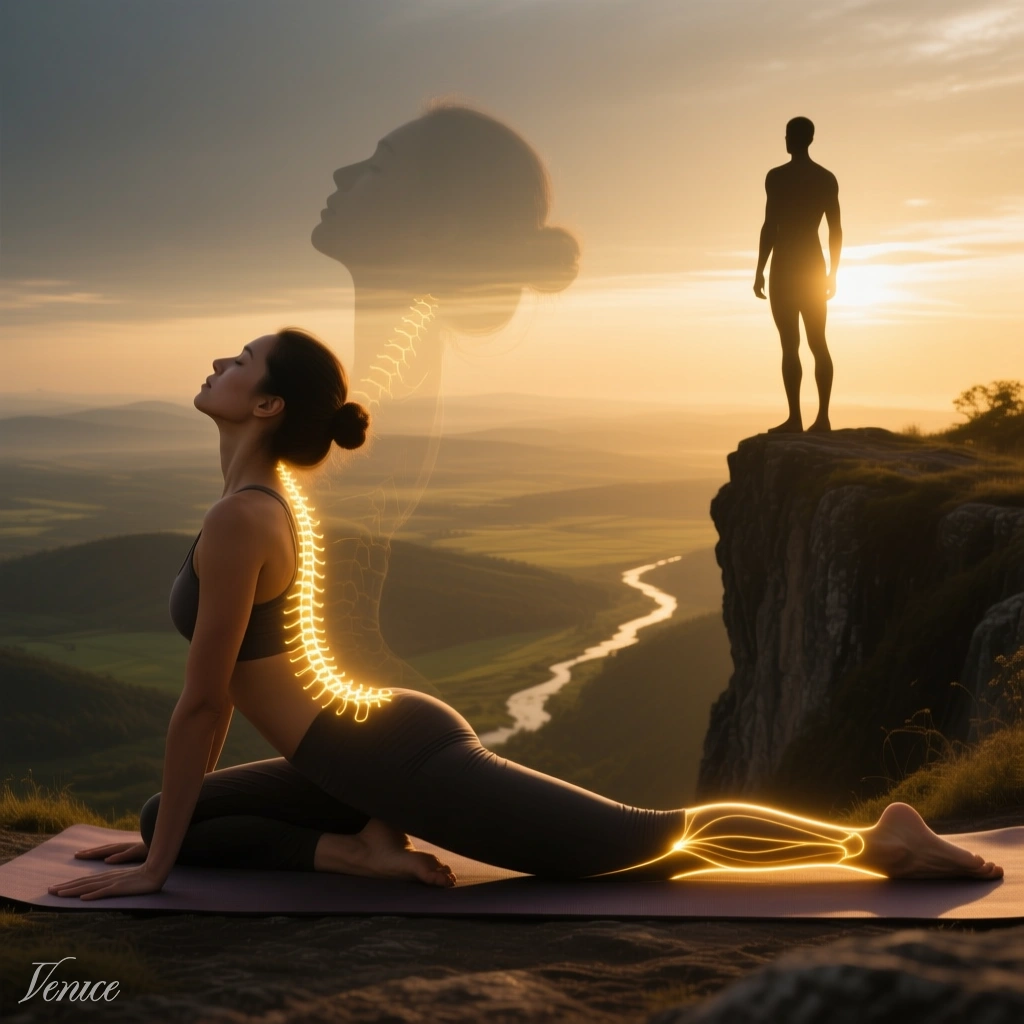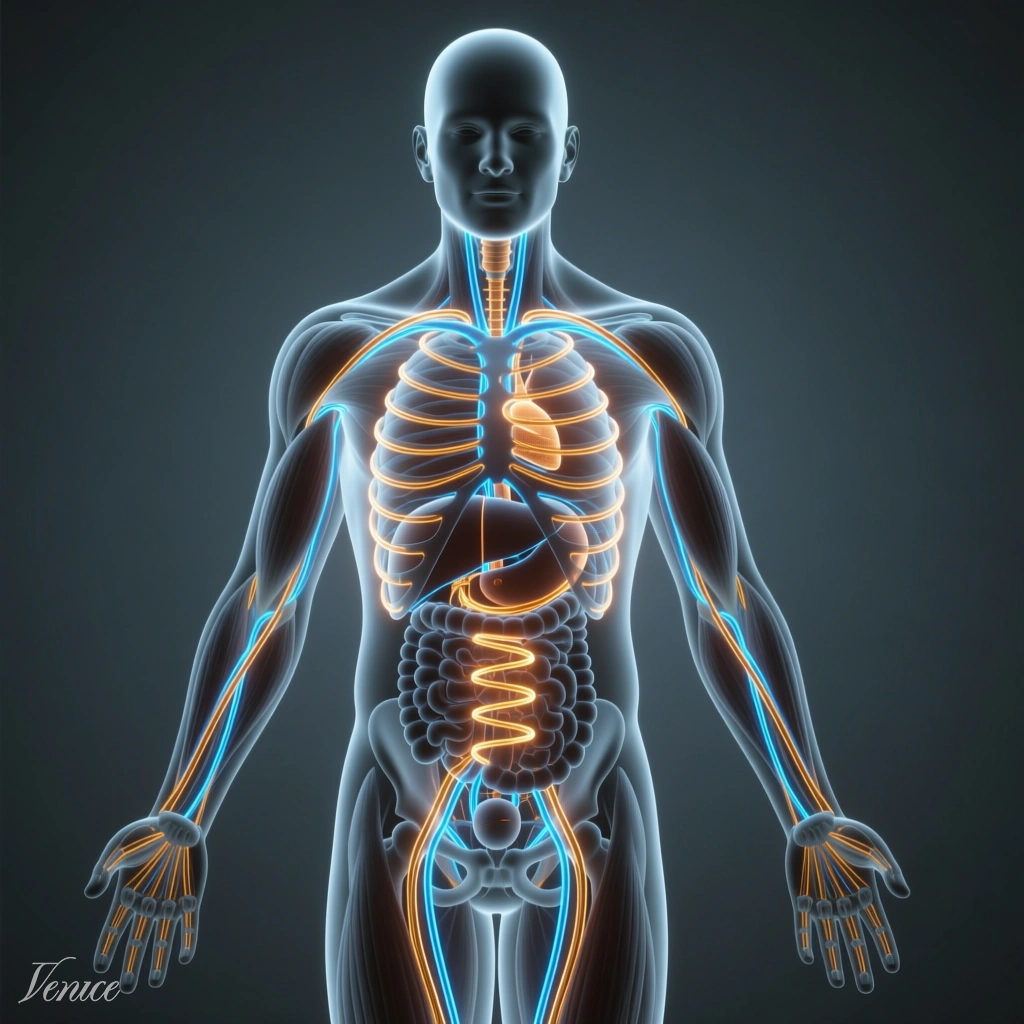
Rediscovering the Energy Body: From Yin Yoga to Bob Cooley’s 16 Meridian System
Oct 11, 2025How a Lifetime of Practice, a Single Acupuncture Session, and a Circle of Wisdom Revealed the Living Map of the Body
There are moments in a teacher’s life when everything you’ve studied, practiced, and taught suddenly folds back on itself and clicks into a higher coherence — like all the pieces of a mandala finally recognizing each other.
Two days ago, during what I thought would be a simple acupuncture session, I found myself in one of those moments.
What began as a conversation about tightness in my hip and shoulder spiraled into a dialogue about energy cycles, organ relationships, and the deep anatomy of healing. The acupuncturist noticed darkness around my right eye and a faint crease between my brows. “Gallbladder,” he said, pointing to the eye. “Liver,” he added, touching the space between my eyebrows. Something in me lit up — not because the diagnosis was new, but because I felt the truth of it.
A Lifetime of Practice Meets a New Perspective
I’ve been practicing yoga for over 30 years, and Yin Yoga has been in my practice for a more than 20 years.
I took my first class in 2001, long before Yin became mainstream, and remember vividly how she spoke about Dr. Hiroshi Motoyama’s research on measurable meridian flow and subtle energy.
Later, my studies in Thai Massage under Master Pichest Boonthume in Chiang Mai confirmed what the Daoists, the yogis, and the scientists each said in their own languages:
“Energy doesn’t just flow in lines — it moves through living tissues, bones, and intentions.”
Pichest would remind us, “Sen runs in the bone.”
Years later I read Dr. Motoyama’s confirmation that energy conductance travels through the periosteum — the connective layer of bone — and smiled.
Different dialects, same truth.
The Question That Changed Everything
After the acupuncture treatment, as my neck loosened and the hip pain softened, one question stayed:
“If the Gallbladder affects the Liver, and the Liver affects the Lungs… what comes before the Gallbladder?”
I knew energy moves cyclically through the meridians — not randomly, but rhythmically, like tides between organs.
So I began digging — into Bob Cooley’s work, into old Yin notes, and into the raw curiosity that has guided me since the beginning.
Meeting Bob Cooley’s Living Map
Cooley, once introduced at the Pacific College of Oriental Medicine as “the man who rediscovered Chinese Medicine,” didn’t learn meridians from books — he discovered them through direct experience.
Decades of stretching and mapping revealed a functional anatomy of energy that integrates biomechanics, psychology, and Daoist theory.
He noticed the body moves in eight directions in both upper and lower halves — sixteen total vectors, each linked to a Yin–Yang organ pair.
He called this one-to-one correspondence Concomitance — the inseparable relationship between structure, energy, and consciousness.
Yin and Yang in the Muscle System
-
Yin muscle groups contract inward, drawing us to center.
-
Yang muscle groups expand outward, opening us into space.
Healthy Yang grounds us; healthy Yin lifts us.
When fascia becomes dense or scarred, energy can’t move — tension replaces stability, heaviness replaces vitality.
It’s the same rhythm that underlies yoga’s nadis and Ayurveda’s doshas: the dance of contraction and release, grounding and rising.
The 16 Meridian System: Completing the Circle
Traditional Chinese Medicine names 12 primary meridians and two extraordinary vessels.
Cooley realized there must be 16 to match the body’s eight-directional architecture, adding:
-
Appendix Meridian – detoxification / external immune
-
Thymus Meridian – internal immunity / belonging
| Organ / Meridian | Tissue | System | Emotional / Spiritual Aspect |
|---|---|---|---|
| Gallbladder | Ligaments | Fat metabolism | Decision & Courage |
| Liver | Tendons | Detoxification | Vision & Direction |
| Lung | Oxygenation | Breath | Inspiration & Grief |
| Large Intestine | Venous flow | Elimination | Letting Go |
| Stomach | Muscles | Digestion | Grounding & Appetite |
| Pancreas | Fascia | Enzymatic integration | Sweetness & Balance |
| Heart | Blood | Circulation | Love & Joy |
| Small Intestine | CSF | Sorting | Clarity & Wisdom |
| Brain | Nerves | Nervous System | Awareness |
| Sexual | Hormones | Reproductive | Creativity |
| Pericardium | Arterial blood | Emotional flow | Compassion |
| Skin | Skin | External immune | Boundaries & Safety |
| Bladder | Bones | Skeletal | Honesty & Endurance |
| Kidney | Joints | Urinary / Fluid | Faith & Adaptability |
| Appendix | Cartilage | Detox / Renewal | Release |
| Thymus | Lymph nodes | Internal immune | Belonging & Hope |
The Cycle of Influence
Energy flows in one continuous circle:
GB → LV → LU → LI → ST → PA → HE → SI → BR → SE → PE → SK → BL → KI → AP → TH → GB
Each organ influences the next — and can even borrow energy from its predecessor.
It’s a self-healing ecosystem of cooperation, not competition.
The Law of Paired Polarity
Every organ exists within a Yin–Yang partnership that mirrors the way one muscle contracts while its opposite releases.
This rhythmic polarity sustains all movement and emotion.
| Yin Organ | Yang Partner | Physical Domain | Tissue Type | Psychological Expression |
|---|---|---|---|---|
| Liver | Gallbladder | Hip stability | Tendons ↔ Ligaments | Vision ↔ Decision |
| Lung | Large Intestine | Shoulder girdle | Oxygenation ↔ Venous flow | Inspiration ↔ Letting Go |
| Stomach | Pancreas | Hip joint | Muscles ↔ Fascia | Appetite ↔ Integration |
| Heart | Small Intestine | Shoulder joint | Blood ↔ CSF | Joy ↔ Discernment |
| Brain | Sexual | Knee joint | Nerves ↔ Hormones | Awareness ↔ Creativity |
| Pericardium | Skin | Elbow joint | Arterial flow ↔ Skin | Compassion ↔ Boundaries |
| Bladder | Kidney | Ankle / Foot | Bones ↔ Joints | Honesty ↔ Faith |
| Appendix | Thymus | Wrist / Hand | Cartilage ↔ Lymph nodes | Detox ↔ Belonging |
When one meridian is blocked, its partner echoes the imbalance.
Healing happens not by domination, but by dialogue.
Concomitance in Motion
The Bladder–Kidney pair offers the clearest example.
The Bladder Meridian runs through the lateral hamstring (biceps femoris).
Stretching that line in Yin poses such as Caterpillar or Half Butterfly engages:
-
The skeletal system (Bladder)
-
The joints and urinary system (Kidney)
-
Emotional tones of honesty, courage, and hope
Every movement carries its psychological counterpart.
You can’t stretch the hamstring without touching the Bladder meridian — or honesty itself.
The Tissue–Emotion Continuum
| Tissue | Meridian | Emotional Polarity | Core Lesson |
|---|---|---|---|
| Ligaments | Gallbladder | Indecision ↔ Courage | Act with Integrity |
| Tendons | Liver | Anger ↔ Vision | Direct Passion |
| Oxygenation | Lung | Grief ↔ Inspiration | Breathe Life In |
| Venous Flow | Large Intestine | Guilt ↔ Release | Let Go Gracefully |
| Muscles | Stomach | Worry ↔ Satisfaction | Trust Nourishment |
| Fascia | Pancreas | Sympathy ↔ Empathy | Integrate Sweetness |
| Blood | Heart | Restlessness ↔ Joy | Lead with Love |
| CSF | Small Intestine | Confusion ↔ Clarity | Discern Essence |
| Nerves | Brain | Anxiety ↔ Awareness | Stay Present |
| Hormones | Sexual | Lust ↔ Vitality | Create Consciously |
| Arterial Blood | Pericardium | Overwhelm ↔ Compassion | Open Safely |
| Skin | Skin | Shame ↔ Presence | Feel Safe in Your Skin |
| Bones | Bladder | Rigidity ↔ Strength | Stand in Truth |
| Joints | Kidney | Fear ↔ Faith | Move Through Uncertainty |
| Cartilage | Appendix | Stagnation ↔ Renewal | Allow Change |
| Lymph Nodes | Thymus | Isolation ↔ Belonging | Trust Connection |
In every Yin pose, one or more of these tissues becomes the “speaker.”
The stretch is simply the microphone.
The Circle of Energy, the Circle of Understanding
My hip and shoulder pain brought me full circle — physical, energetic, emotional, and psychological.
The Gallbladder wasn’t failing me; it was speaking.
Pain was information, guiding me to listen to the whole system rather than a single symptom.
The Web of Teachers
Gratitude to:
-
Bob Cooley – mapping the 16 meridians and showing that stretching is psychology in motion.
-
Paul Grilley – translating meridians into Yin Yoga language.
-
Dr. Hiroshi Motoyama – measuring the immeasurable.
-
Pichest Boonthume – proving that Sen runs in the bone.
-
And to every healer and student who reminds me that the body is intelligent beyond measure.
Returning to the Whole
The energy body isn’t mystical — it’s physiological.
Each tissue, emotion, and thought is a visible echo of invisible flow.
When we stretch the hamstrings, we polish honesty.
When we open the liver line, we remember direction.
When we breathe into the lungs, we rediscover courage to grieve and begin again.
The body heals not by parts, but by pattern.
Wholeness is restored when we remember the circle.
Living in the Circle
Thirty-five years in, I’m still humbled by the depth of this design.
That one acupuncture insight connected Bob’s meridians, Paul’s Yin lineage, Pichest’s Sen lines, and my own practice into a single living circle.
Healing never moves in straight lines — only spirals of remembering.
Energy is not something you use. It is something you become conscious of.
Continue the Journey →
Explore the full 16-Circuit Meridian Map and the elemental correspondences behind this practice in The Map and the Journey.




